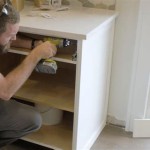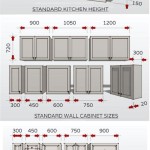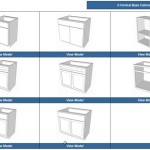Cabinet Storage Ideas For Kitchen
The kitchen, often considered the heart of the home, is a space where functionality and aesthetics must coalesce. Effective cabinet storage is paramount in achieving both. A well-organized kitchen minimizes clutter, streamlines cooking processes, and enhances the overall visual appeal of the space. This article explores various cabinet storage ideas applicable to different kitchen layouts and organizational needs.
Maximizing Vertical Space with Pull-Out Shelves and Drawers
One of the most efficient methods for optimizing cabinet space is the implementation of pull-out shelves and drawers. Standard cabinet shelves, while functional, often lead to items being lost in the back, resulting in wasted space and difficulty accessing stored goods. Pull-out mechanisms address this issue by bringing the entire contents of the cabinet within easy reach.
Pull-out shelves are particularly beneficial for storing bulky items such as pots, pans, and small appliances. The ability to slide the shelf out eliminates the need to reach deep into the cabinet, reducing the risk of dropping items or straining oneself. Similarly, pull-out drawers are ideal for storing dry goods, spices, and utensils. The enclosed nature of a drawer prevents items from shifting or falling, maintaining a more organized and visually appealing storage solution.
Installation of pull-out shelves and drawers can be either a DIY project or professionally implemented. Pre-made pull-out units are available in various sizes and materials, allowing for customization to fit existing cabinet dimensions. For a more tailored solution, custom-built pull-outs can be designed and installed to perfectly match specific storage requirements. Regardless of the installation method, it is crucial to accurately measure cabinet interiors to ensure proper fit and functionality.
The material choice for pull-out shelves and drawers is also a significant consideration. Common materials include wood, wire, and metal. Wooden shelves offer a classic and aesthetically pleasing look but may require more maintenance to prevent warping or damage from moisture. Wire shelves provide good ventilation and visibility but may not be suitable for storing small or loose items. Metal shelves are durable and easy to clean, making them a practical choice for heavy-duty storage.
Optimizing Corner Cabinets with Lazy Susans and Blind Corner Pull-Outs
Corner cabinets often present a unique storage challenge. Their unconventional shape and limited accessibility can lead to significant wasted space. Lazy Susans and blind corner pull-outs are two popular solutions designed to effectively utilize these difficult-to-reach areas.
Lazy Susans, also known as revolving shelves, consist of a circular platform that rotates within the cabinet. This rotating mechanism allows for easy access to items stored at the back, eliminating the need to reach blindly into the corner. Lazy Susans are particularly useful for storing items such as canned goods, spices, and small appliances. They are available in various sizes and materials, including plastic, wood, and metal, allowing for customization to match existing cabinet aesthetics.
Blind corner pull-outs, on the other hand, are designed to address the issue of inaccessible space in cabinets with a "blind" corner (a corner that extends further back than the cabinet opening). These systems typically consist of a series of interconnected shelves or baskets that slide out of the cabinet, bringing the contents into full view. Some blind corner pull-outs also feature a pivoting mechanism that allows the shelves to swing out of the cabinet, maximizing accessibility.
When choosing between a Lazy Susan and a blind corner pull-out, it is important to consider the specific storage needs and the configuration of the corner cabinet. Lazy Susans are generally more suitable for storing a variety of smaller items, while blind corner pull-outs are better suited for larger or irregularly shaped items. The cost of installation is also a factor, with blind corner pull-outs typically being more expensive due to their more complex mechanism.
The installation of both Lazy Susans and blind corner pull-outs can significantly enhance the functionality of corner cabinets. By providing easy access to previously inaccessible areas, these storage solutions can help to maximize space utilization and improve overall kitchen organization.
Utilizing Door and Wall Space with Over-the-Door Organizers and Hanging Racks
Beyond the interior of cabinets, the door and wall space within a kitchen can also be effectively utilized for storage. Over-the-door organizers and hanging racks provide additional storage options without requiring significant renovations or modifications to existing cabinetry.
Over-the-door organizers are typically made of metal, plastic, or fabric and are designed to hang over the back of cabinet doors. These organizers feature a series of pockets, shelves, or hooks that can be used to store a variety of items, such as cleaning supplies, spices, and baking tools. Over-the-door organizers are particularly useful for storing smaller items that would otherwise clutter countertops or cabinet shelves.
Hanging racks, on the other hand, are typically mounted to the wall and can be used to store pots, pans, utensils, and other frequently used items. Hanging racks are available in a variety of styles and materials, including metal, wood, and stainless steel, allowing for customization to match existing kitchen décor. They can be installed on walls, above countertops, or even suspended from the ceiling, depending on the available space and storage needs.
When installing over-the-door organizers or hanging racks, it is important to consider the weight-bearing capacity of the door or wall. Overloading these storage solutions can lead to damage or breakage. It is also important to ensure that the installation does not interfere with the opening or closing of doors or drawers.
The use of over-the-door organizers and hanging racks can significantly increase the storage capacity of a kitchen without requiring significant renovations. By utilizing previously unused space, these storage solutions can help to declutter countertops and cabinets, creating a more organized and functional kitchen environment.
Implementing Drawer Dividers and Organizers for Utensils and Cookware
Maintaining organized drawers is crucial for kitchen efficiency. Drawers, when left unmanaged, can quickly become chaotic, making it difficult to locate utensils, cookware, and other essential items. Drawer dividers and organizers offer a practical solution for compartmentalizing and streamlining drawer contents.
Drawer dividers physically separate the drawer space into distinct sections, preventing items from shifting and intermingling. These dividers can be fixed or adjustable, allowing for customization to accommodate various item sizes and shapes. Common materials for drawer dividers include wood, plastic, and metal. Wooden dividers offer a classic and aesthetically pleasing look, while plastic and metal dividers are more durable and easy to clean.
Drawer organizers, on the other hand, are designed to hold specific types of items, such as utensils, silverware, or cookware. These organizers often feature pre-formed compartments or slots that provide a dedicated space for each item. Utensil organizers typically have separate compartments for spoons, forks, knives, and other serving utensils. Silverware organizers provide a similar function but are designed for more formal dining utensils. Cookware organizers can hold pots, pans, lids, and other cooking equipment, preventing them from clanging together and causing damage.
When selecting drawer dividers and organizers, it is important to consider the dimensions of the drawers and the types of items that will be stored. Accurate measurements are crucial to ensure a proper fit. It is also important to consider the material and construction of the dividers and organizers. High-quality materials and sturdy construction will ensure that the organizers can withstand frequent use and maintain their shape over time.
By implementing drawer dividers and organizers, it is possible to transform cluttered drawers into well-organized and efficient storage spaces. This can save time and frustration when searching for specific items and contribute to a more streamlined and functional kitchen environment.
Strategic Placement and Categorization for Efficient Workflow
The effectiveness of any kitchen storage solution is contingent upon strategic placement and logical categorization. Simply installing storage solutions without considering the flow of kitchen activities will result in a disorganized and inefficient space. Careful consideration must be given to the placement of frequently used items and their proximity to relevant work areas.
Items that are used most frequently should be stored in easily accessible locations, such as within reach of the primary work area. This minimizes unnecessary movement and allows for quick and efficient retrieval. For instance, utensils used for cooking should be stored in a drawer or container near the stovetop, while cutting boards and knives should be stored near the countertop where food preparation takes place.
Categorization is equally important. Grouping similar items together makes it easier to locate what is needed and prevents clutter from accumulating. For example, all baking supplies, such as flour, sugar, and measuring cups, should be stored together in a designated cabinet or pantry area. Similarly, all cleaning supplies should be stored in a separate location, away from food preparation areas.
Consider the "work triangle" when planning kitchen storage. The work triangle is a concept that designates the three primary work areas in a kitchen: the sink, the refrigerator, and the stovetop. The placement of these three areas should be designed to minimize the distance between them and facilitate efficient workflow. Storage solutions should be strategically placed around these work areas to support the tasks performed in each zone.
Labeling is a simple but effective technique for maintaining an organized kitchen. Labeling shelves, drawers, and containers helps to identify the contents and ensures that items are returned to their proper place after use. This prevents items from being misplaced and reduces the need to search through multiple locations to find what is needed. Clear and concise labels can be created using a label maker or handwritten on adhesive tags.
Strategic placement and logical categorization are essential for creating a functional and efficient kitchen. By considering the flow of kitchen activities and organizing items accordingly, it is possible to maximize the benefits of any storage solution and create a space that is both aesthetically pleasing and highly practical.
Considerations for Small Kitchens and Limited Cabinet Space
Small kitchens present unique challenges in terms of storage. Limited cabinet space necessitates creative and resourceful solutions to maximize every available inch. Strategies for small kitchens focus on multi-functional items, vertical storage, and decluttering to optimize the compact layout.
Multi-functional items are particularly valuable in small kitchens. Consider using items that serve multiple purposes, such as nesting bowls, stackable containers, or cutting boards that can also be used as serving platters. These items take up less space than individual pieces and allow for a more efficient use of storage space.
Vertical storage becomes even more critical in cramped kitchens. Utilizing wall space and maximizing the height of cabinets can significantly increase storage capacity. Installing shelves above countertops, using hanging racks for pots and pans, and employing tall, narrow cabinets can all contribute to maximizing vertical space.
Decluttering is an ongoing process that is essential for maintaining an organized small kitchen. Regularly assess the contents of cabinets and drawers and remove any items that are no longer used or needed. This frees up valuable space and prevents clutter from accumulating. Consider donating unwanted items to charity or selling them online.
Open shelving can also be a useful solution for small kitchens, but it requires careful planning and maintenance. Open shelves can provide easy access to frequently used items and create a more open and airy feel in the kitchen. However, it is important to keep open shelves organized and clutter-free to prevent them from looking messy and overwhelming.
In small kitchens, it is crucial to prioritize storage based on frequency of use. Items that are used most often should be stored in easily accessible locations, while less frequently used items can be stored in higher or less accessible cabinets. Consider storing seasonal items, such as holiday decorations or specialized cooking equipment, in a separate storage area outside of the kitchen.
By implementing these strategies, it is possible to create a functional and organized kitchen, even in a small space. Resourcefulness, creativity, and a commitment to decluttering are key to making the most of limited cabinet space and creating a kitchen that is both practical and aesthetically pleasing.

The 15 Most Popular Kitchen Storage Ideas On Houzz

The 15 Most Popular Kitchen Storage Ideas On Houzz

5 Best Kitchen Storage Ideas You Must Know Oppein

25 Best Ideas For How To Organize Kitchen Cabinets

The 15 Most Popular Kitchen Storage Ideas On Houzz

Clever Kitchen Storage Ideas For Your Home Designcafe

11 Kitchen Cabinet Storage Ideas You Ll Fall In Love With

Custom Cabinet Storage Solutions Kitchen Magic

4 Clever Corner Kitchen Cabinet Storage Ideas

41 Genius Kitchen Organization Ideas The Family Handyman
Related Posts








